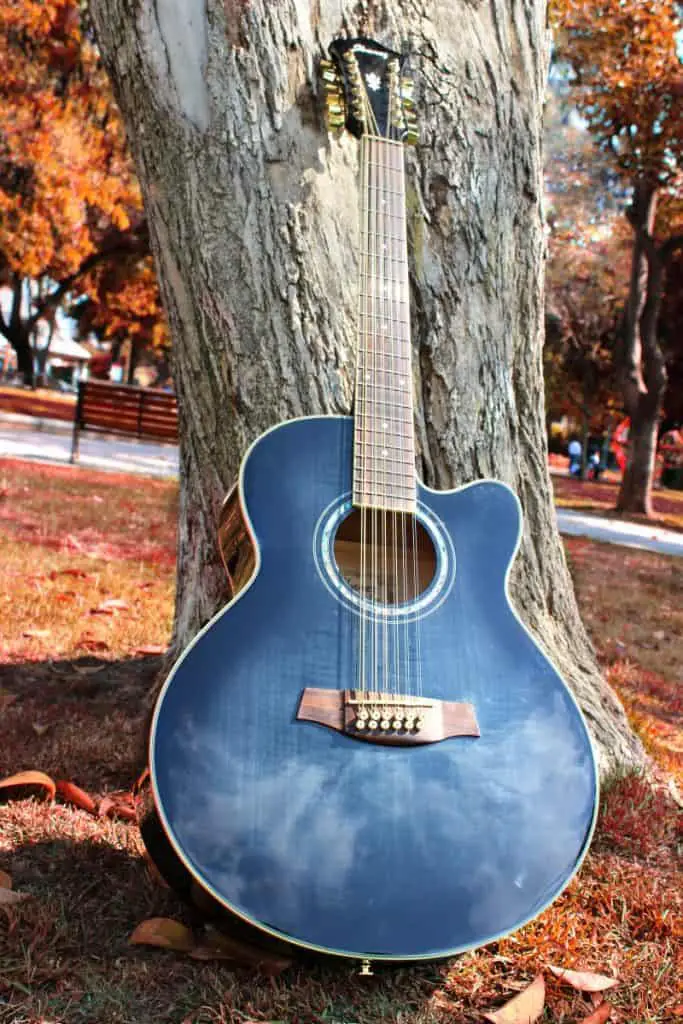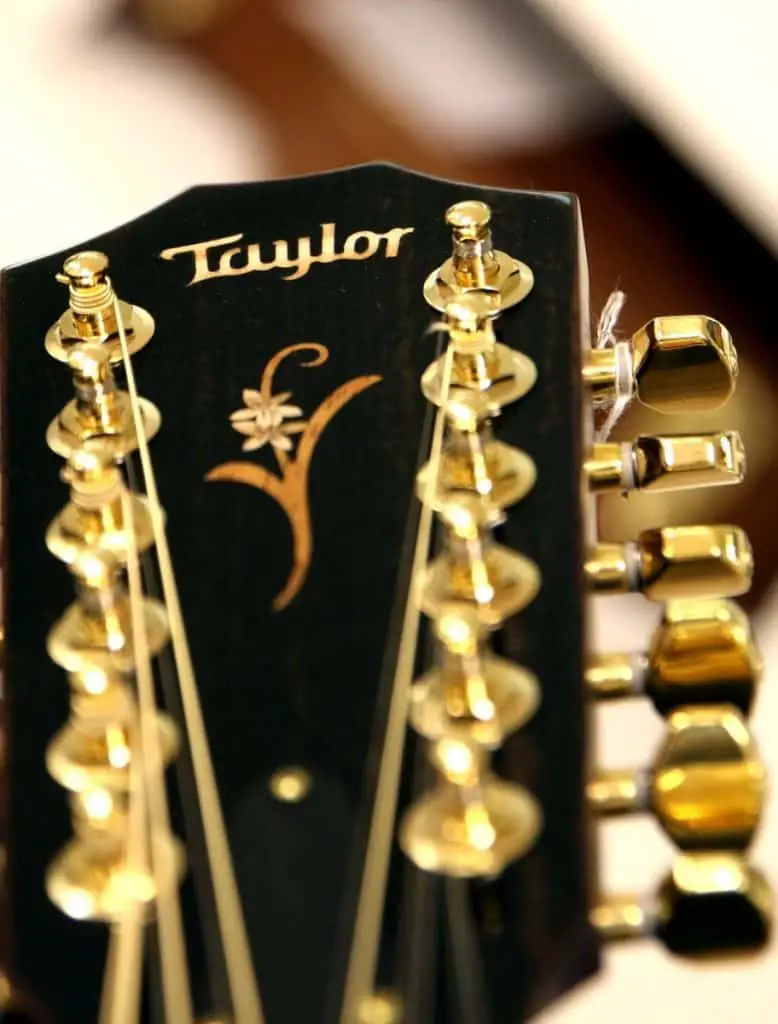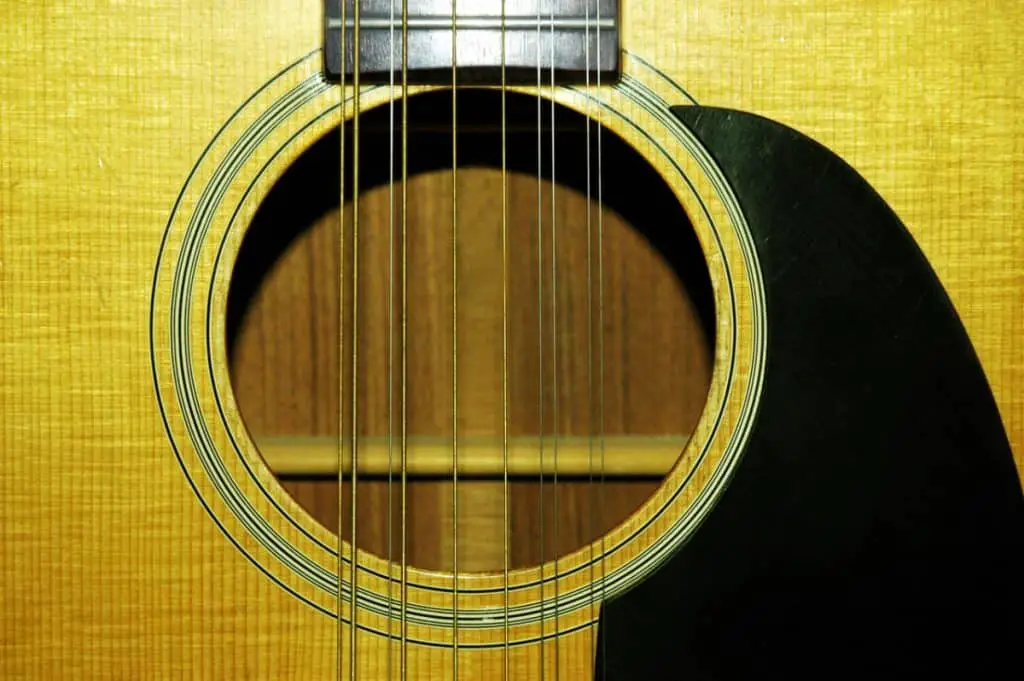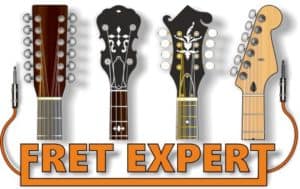If you’re planning to buy your 12-string guitar brand new from a music store, this question becomes a little simpler than any online purchase you might make.
However, I know many people buy pre-owned, used 12 string guitars, or look for them online. Online guitar stores often have a much wider choice and range of prices if you’re buying new, too.
No matter where you’re buying your new 12 string guitar, I’m going to lay out a series of useful pointers that should lead you down the right path.
Many of these tips apply even if buying online, because you can always return the guitar after handling it and making these checks.
Tip: If you’re looking to buy a new 12 string and you’re a beginner, you’ll definitely want to check out my pick of the best 12 string guitars for new players and also a beginner’s guide to the 12 string guitar.
Covered in this Article:
1. Playability
For most musicians, this should be the number one priority. It’s easy to get dazzled by the overall look of an instrument and not pay as close attention to the fundamentals as you should.
If you can, check every single fret position on every string to see if you get any dead spots or fret buzz. Problems like this can be fixed later by a guitar technician or luthier (stringed instrument maker), but it will significantly add to your bill. It’s best avoided by selecting a different instrument if need be.
Secondly, a 12-string guitar with a high action is going to be very difficult to play further up the fingerboard, so see how easy it is to press down the strings on the twelfth fret. If it takes a lot of effort, you’ll very likely be dealing with an instrument with too high a saddle.
The saddle can generally be lowered by sanding the bottom of it to a more acceptable height, but again, this is a job for a more experienced musician or tech guy.
If the action is really poor, sanding down the saddle may not alleviate the problem. This is less of an issue on a 12-string electric as they often have adjustable bridges/saddles.
Lastly, check the intonation. This is how accurate the pitch of the guitar sounds at every position on the fingerboard.
Realistically, it’s hard to find an instrument that’s one hundred percent accurate because the nature of the beast dictates that the guitar is an instrument of equal temperament (pitch-wise, every note having an equal musical ratio with regard to its vibrating frequency).
A badly set up instrument with inaccurate fret spacing can sound too pitchy to be playable. So test your open string and compare the pitch on that same string an octave up, by fretting on the twelfth fret. If it sounds really off, you have a problem.
The reason for this happening can be caused by a few possible issues, including that the nut and action are much too high or the neck is warped.
You’re unlikely to suffer these types of issues on a higher-priced 12 string guitar or from a specialist guitar store, where they probably set the instruments up to a certain degree.

2. Electronics
This only applies to 12-string electro-acoustic and electric models.
Check the jack socket to see if it feels loose. From personal experience, I purchased a Fender Telecaster many moons ago and the socket was very loose, causing the guitar to cut in and out. Unfortunately, this wasn’t a straight forward tightening up job and needed a guitar guy to fix the problem.
Check the volume and tone control pots/sliders for obvious crackling or cutting in and out. If this is happening it probably needs to go to the repair shop – avoid!
You’ll also likely have a pickup selector switch on an electric 12-string, which you need to check is working properly. Most selector switches will have the option of using only the bridge or neck pickups and a central position for a mix of the two. If one of these is dead, again, steer clear of it.
On an electro-acoustic 12 string guitar, it may have a built-in tuner. Check to see if this works, if you aren’t sure and you’re in a store, ask for it to be demonstrated.
3. Woods
This is generally a case of you get what you pay for.
Some cheaper 12 string guitars are likely to use laminates to save on money. This doesn’t have to be a deal changer even if it isn’t constructed from solid tonewoods such as spruce or mahogany.
Let your ears do the work and if you like how it sounds, let that lead your decision. The only point I would make is solid tonewoods will make a good guitar even better with a little aging.
This leads me onto a major issue facing today’s instrument manufacturers and independent luthiers. The unavailability of certain woods, through deforestation and the plundering of indigenous trees, has led to CITES (or The Convention on International Trade in Endangered Species of Wild Fauna and Flora).
To put it simply, certain woods that were regularly harvested by instrument and furniture manufacturers are now on the official banned list. Quoting Bob Taylor, the co-founder of Taylor Guitars on this very subject:
“I used to buy Brazilian rosewood back in the 1970s at the lumberyard for $2 a square foot. Now it’s impossible for us to make a guitar out of it and ship it outside the U.S. If we do get a little bit of it, it’s extremely expensive. The cutting of it has all but halted. Adirondack spruce is unavailable. Mahogany was so plentiful it was a commodity. Now only specialty cutters are getting it and the prices have gone through the roof. All these things happened just in my lifetime.”

So which woods are used, and what’s the difference between them?
Typical woods for an acoustic 12-string guitar:
Top
Spruce: The varieties include: Sitka, Englemann (or European Spruce) and Adirondack (or Eastern Red Spruce). The most popular choice of tonewoods for the top.
Cedar: Another popular choice with manufacturers, for its rich tonal qualities. Physically, it’s less dense in composition than spruce.
Mahogany: A very popular material for backs and sides of the guitar, it nonetheless holds its own position as an interesting alternative with a characteristically warm tone.
Maple: Again, a popular wood for necks, backs, and sides of guitars, but not as frequently seen as a top wood. It does produce a nice bright tone, though.
Back & Sides
Rosewood: The main varieties are Eastern Indian and Brazilian Rosewood. Brazilian is now subject to CITES rules and very hard to find, other than on older 12 string guitars in the used guitar market. It’s renowned for its deep, rich and bright tonal qualities.
Mahogany: Its beautiful red-brown hue makes it instantly recognizable. It produces a lovely warm tone with strong basses and balanced mid-range tones.
Sapele (sap-pee-lee): This originates from Africa and is very similar in its tonal qualities to Mahogany. Grain-wise, it’s a little lighter in color. Produces a clear warm tone.
Maple: Two main varieties – Curly (or Flamed Maple) and Quilted. Not as common as the other woods for the backs and sides, this dense hardwood produces a clear tone and a slightly quicker decay on the notes. A good choice for those wanting a ‘live’ performance instrument with very precise clear tonal qualities.
Koa: The number one tonewood for ukuleles, this indigenous Hawaiian wood is a slightly left-field choice for guitar manufacturers due to its limited availability and tonal brightness. Not necessarily the choice for plectrum users.
Walnut: Quite similar to koa in that it produces a characteristically bright tone, but will age gracefully and acquire more warmth. It features an instantly recognizable stripy appearance.
Neck & Fingerboard (or Fretboard)
Rosewood: As discussed earlier, it comes in two varieties – Brazilian and Indian. A very popular wood for fingerboards with its hard wearing, yet smooth physical qualities.
Most recently built 12 string guitars are likely to be made from Indian Rosewood. Another quality that adds to its popularity is the natural oiliness of the wood, so it doesn’t need any further finishing to make it playable.
Ebony: Another very popular hardwood for fingerboards, particularly with electric guitars. Color-wise it’s easily recognized by its very dark hue. Like Rosewood, it has its own inherent oily qualities. In conjunction with other woods, it can produce a bright clear sound with plenty of smooth sustaining properties.
Maple: Less frequently used on acoustic guitar fingerboards, but very popular on electric guitars. Appearance-wise, not a common choice for acoustic guitar manufacturers, who prefer darker tonewoods for their instruments. Aesthetically, an unusual choice unless you want a unique looking instrument.
Walnut: Again, an unusual choice for fingerboards, but a tough wood like rosewood and ebony which is more often seen on the backs and sides of guitars. An interesting alternative, though.
Micarta: Something of a misnomer under this section, as it’s not really a tonewood, but a mix of composite materials bonded together by resins. Much cheaper to produce and very hard-wearing.
Electric 12-string Guitar Bodies
Arguably, this is less critical to the overall sound of the guitar than the choice you make with an acoustic model (although many would dispute this!)
Electrics are typically built from woods such as Maple, Alder, Rosewood, Ash, Basswood, Mahogany, Maple, Poplar, Korina, Bublinga, Walnut, and Koa. The first six are the most popular.
As your sound will be shaped in many other ways, any missing qualities within the wood itself can be compensated with the use of pickups, amplifiers, modeling software and effects units.

4. Hardware
Tuning Pegs/Machine Heads: Always check these to make sure they aren’t too spongy and loose or you may end up with tuning problems.
Also, the response should be automatic and not a sudden jerky pitch shift as you rotate it – i.e. no effect and then it detunes too far, too quickly.
On the obverse side, very stiff tuners carry their own issues, making tuning up a very ‘physical’ experience! The more expensive models will almost certainly feature very solid reliable tuners.
For innovative machine head design, Rickenbacker takes the top prize when it comes to 12-string electrics. Instead of the usual six in a row each side, the tuners are arranged at right angles to each other on both sides of the headstock. This makes the instrument a lot less unbalanced – a common fault with 12-strings.
As far as nuts and saddles go, you’re likely to find some form of hard plastic used on cheaper models.
As you go up through the more expensive instruments, better tonal materials are used – the most popular is bone, with its excellent sustaining qualities.
To be fair, not all synthetic materials are ‘bad’ when it comes to nut application. Materials such as Tusq, Micarta and Corian are decent alternatives but aren’t quite as long-lasting as bone is.
A material similar to bone is ivory, or more accurately, fossilized ivory, as opposed to some idiot taking a pot shot at an elephant or walrus. The source of these is a little too questionable in my opinion.
Other options are graphite, PTFE (or Teflon!) and mother of pearl. Brass is also occasionally used and of course quite frequently in its chromium-plated form on most electrics, with saddles and bridges.
In the end, all of the above information is nice to know, but the important thing is how you react to an instrument when you first pick it up. If it feels nice and plays well, the addition of a bone nut or Brazilian Rosewood body doesn’t add up to a row of beans!
Certainly, it’s likely to be better with some of the qualities I’ve mentioned, but not having them doesn’t automatically make them deal-breaking additions or omissions.
